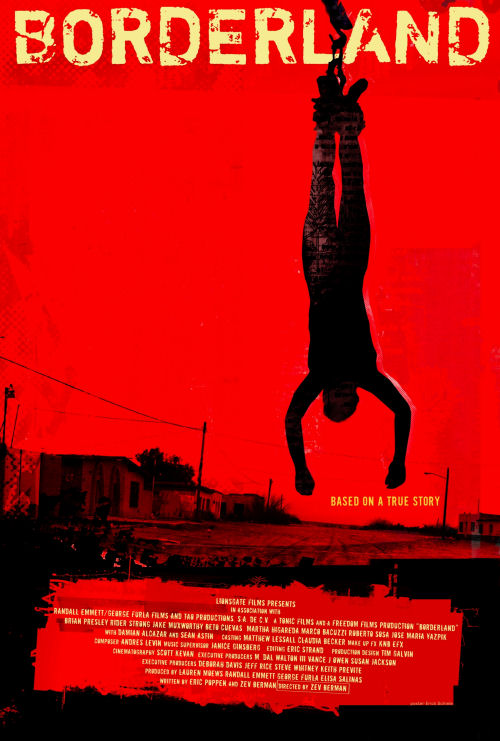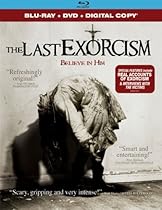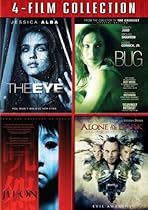 One of the “8 Films to Die For” in the 2007 edition of the After Dark Horrorfest, BORDERLAND is a tense, bloody thriller that raises questions about how we define the horror genre. In essence, this is a story about three gringos who go south of the border for a weekend in Mexico, only to run afoul of a local drug lord named Santillan; it is more a crime melodrama than a horror film, except that the film likes to dwell on the bloody methods employed by Santillan and his minions. These are rendered in graphic, horrifying detail, but they are not much more violent than what you would see in SCARFACE (both films feature severed limbs, although here the weapon of choice is a machete rather than a chainsaw). What really kicks the film into the borderland of the horror genre is the aura of superstitious dread surrounding Santillan, a cult leader who uses Santeria rituals and human sacrifices to render his runners “invisible” to the police (or so they believe). The unnerving confidence of his minions, who brag that their souls are dead and claim “jails cannot hold us; bullets cannot harm us” does send an uncanny chill down the spine – enough to qualify this as a borderline horror effort.
One of the “8 Films to Die For” in the 2007 edition of the After Dark Horrorfest, BORDERLAND is a tense, bloody thriller that raises questions about how we define the horror genre. In essence, this is a story about three gringos who go south of the border for a weekend in Mexico, only to run afoul of a local drug lord named Santillan; it is more a crime melodrama than a horror film, except that the film likes to dwell on the bloody methods employed by Santillan and his minions. These are rendered in graphic, horrifying detail, but they are not much more violent than what you would see in SCARFACE (both films feature severed limbs, although here the weapon of choice is a machete rather than a chainsaw). What really kicks the film into the borderland of the horror genre is the aura of superstitious dread surrounding Santillan, a cult leader who uses Santeria rituals and human sacrifices to render his runners “invisible” to the police (or so they believe). The unnerving confidence of his minions, who brag that their souls are dead and claim “jails cannot hold us; bullets cannot harm us” does send an uncanny chill down the spine – enough to qualify this as a borderline horror effort.
Genre labels aside, BORDERLAND is thoroughly engrossing, building effectively toward a grueling climax. The sense of growing dread is almost palpable. Although punctuated with visceral thrills, the real engine driving the film is fear of what will happen next, coupled with a sense of being helpless in the face of a seemingly all-powerful enemy.
The screenplay creates a completely believable situation, populated with believable people – not the moronic victims typical for this kind of thing. The writing evinces an easy knack for throwing in surprising little details that humanize the situations, which are expertly executed by the cast and the director. When Phil (Rider Strong), the virgin of the American trio on vacation, realizes that the prostitute his friend has set him up with has a baby, instead of being turned off, he finds himself endeared; what started as a quick sexual tryst turns into a potential relationship, and the actor totally sells the transition, elevating the scene from a cliched sexual fantasy to a moment of real drama.
The script also walks the tightrope of creating characters who try to do the right thing under difficult circumstances – without turning them into heroes who will obviously win. This is most obviously the case with Valeria (the appealing Martha Higareda): although introduced as a bartender who can take care of herself in a rough crowd, she never morphs into an invincible superwoman.
Likewise with the rest of the cast: Damian Alcazar provides a vivid portrait of Ulisis, a former cop, haunted by the death of his partner, to hunt for the truth, but he’s no LETHAL WEAPON-clone. In the role of Ed, the thoughtful member of the group, Brian Presley (who suggests a young Tom Cruise – if he weren’t a movie star but just a good actor) may be sincere when he says he would shoot a man “if I had to,” but that hardly inspires much confidence heading into the climax. On the far end of the scale, Jake Muxworthy deserves special note for playing the obnoxious jerk of the group and managing to make him sympathetic; after the character has a near-fatal encounter with Santillan’s strongman, it really hurts to see the once cocky and confident character reduced to shattered cowardice.
This approach is the fim’s masterstroke, keeping the story convincing throughout, never sliding into comfortable Hollywood territory. When Henry nearly gets killed, instead of being inspired to seek payback (like so many movie characters), the terrifying incident far more believably breaks his spirit. Even later, when Ed, Valeria, and Ulises arm themselves and rescue Phil, there is no thrill of anticipatory excitement (“Oh boy, now they’re gonna kick ass!”); you just fear that they are walking into the lion’s den, probably to their doom.
Director Zev Berman plays his hand deftly, throwing down winning trump cards at big moments. For example, the script tells us about Santillan long before revealing him, lending an almost mythical aura to the character. When he finally appears (masterfully embodied by Beto Cuevas), Berman somehow – incredibly – manages to make the man live up to the myth, giving us a Santillan who is both sinister and charismatic, who could both instill fear and hold his followers in a thrall. What could have been a terrible disappointment becomes instead a step deeper into the Heart of Darkness.
The reference to Joseph Conrad is no accident. Although allegedly based on true events, the structure of the story clearly owes a debt to Heart of Darkness(or perhaps more directly to its cinematic heir, APOCALYPSE NOW). Certainly, the overall narrative thread is of “civilized” white people moving through a primative terrain toward an eventual confrontation with Kurtz-like figure who has thrown off all the shackles of society and set himself up as a local god. There is even an American acolyte (obviously modeled after the Dennis Hopper character in Coppola’s movie) who visits the kidnapped American in his cell and mouths some semi-coherent ramblings about the supposedly great man he serves.
The portrait of a seedy border town where anything can happen is painted in fine detail, especially, the bordello. The dinginess of the setting is far removed from the idyllic fantasy of sexual freedom that one might see in a teen-comedy, but it stops short of going so far that you never believe the characters would set foot in it.
With this portrait of the land South of the Border infested with superstitious customs and primitive evil ready to destroy the unwary white man who naively ventures into it, BORDERLAND certainly plays on the stranger-in-a-strange land fears. Fortunately, the handling of the material is too sophisticated to be overtly racist, being nicely balanced with sympathetic local characters. There is also some dialogue indicating that the danger resides not so much in Mexico as in the Borderland of the title – a scary sort of neutral zone where the usual rules of society do not apply and where the law barely exists.
This suggests a deliberate attempt to satirize the simple-minded Republican philosophy voiced by Henry early in the film (who derides the poor for being lazy and evokes Mexico as a place where a man can truly be free instead of living in the over-regulated United States). BORDERLAND takes this libertarian view of paradise (no law, no government, just rich people doing what they want) and turns it on its head in a particularly brutal and ugly way, without expressing a political point of view in a heavy-handed way.
Unfortunately, after the suspense is played out and you look back on the result, you realize that it is a missed opportunity. BORDERLAND fails in never fully realizing its thematic undercurrents regarding superstition. Santillan is presented as someone who may have supernatural powers – at least he is believed to have them, by both his followers and those who fear him. The film seems briefly to be wrestling with this issue near the climax, when Santillan’s intended victim quotes the famous Psalm 23 (“The Lord is my Shepherd…”) during the ritual.
For a brief moment, two alternate belief systems come into direct conflict (a familiar theme in the horror genre). Rather like THE STRANGLERS OF BOMBAY, the old Hammer Horror film about the Thugee cult in India (in which a battle between a snake and a mongoose is elevated to a symbolic stand-off between good and evil), it seems as if BORDERLAND is catapulting onto an entirely different level, in which the action is no longer merely about life and death but truly about Good and Evil in a metaphysical sense. Alas, it comes to nothing. The supernatural suggestions are simply window dressing, and the script has nothing to say about the religious undertones, opting instead for the easier, obvious, and fairly familiar message that ordinary people can and will turn violent and savage if pressed hard enough to defend themselves and/or avenge their friends.
This is not far from standard exploitation territory, sadly, and using the old “based on a true story” gambit as a justification only further degrades the film. BORDERLAND really is not interested in exploring a real-life scenario in all its complexity. You will not learn any insightful lessons about how a cult can grow, thrive, and survive in the modern world; or about why local institutions like law enforcement were unwilling or unable to combat it; or about what finally brought an end to the cult after years of apparent invulnerability. All that takes a back-seat to the bloodshed, which is the film’s true raison de’tre.
Luckily, fumbling the interesting ideas in favor of opting for the lowest-common-denominator appeal does not undermine the effectiveness of the storytelling. As unsavory as the approach can be, it remains griping to the end, even when you wish the ambition had been aimed a little higher. The closest relative may be WOLF CREEK (which also claimed to be based on a true story), but in many ways BORDERLAND is the better film, unburdened with a bad ending. It may be flawed, but BORDERLAND remains a darkly disturbing – probably the most genuinely frightening of the 2007 After Dark horror films.
[serialposts]

 As if that were not enough for penny-pinching purchasers, there is a series of discs bearing the label “Four Film Collection,” which true to their name offer a quadruple does of terror. Sometimes the combinations seem apprpriate; at other times, it seems like whatever was contractually available was thrown together. For example, putting LEPRECHAUN 1 through 4 in a package makes sense (or at least as much sense of releasing a LEPRECHAUN movie can), but simultaneous releasing a disc with PUMPKIN HEAD II, LEPRECHAUN, WISHMASTER, and WISHMASTER 2 is a bit of a jumble. Even more discordant is the combination of THE EYE (the American remake of the Chinese original), JU-ON: THE GRUDGE (the Japanese original that was remade with American stars), BUG (the psycho-drama directed by William Friedkin), and ALONE IN THE DARK (an obscure thriller starring Christian Slater as a private investigator who specializes in supernatural phenomena). A bit more comfortable nestled together are BORDERLAND, DARK RIDE, UNEARTHED, and THE GRAVE DANCERS: although not labeled as such, all of these titles have appeared under the After Dark Horrorfest label, which gives weekend-long theatrical exposure to films that otherwise would go straight to video. Of these, THE GRAVE DANCERS is probably the best film ever to screen as part of the horror fest.
As if that were not enough for penny-pinching purchasers, there is a series of discs bearing the label “Four Film Collection,” which true to their name offer a quadruple does of terror. Sometimes the combinations seem apprpriate; at other times, it seems like whatever was contractually available was thrown together. For example, putting LEPRECHAUN 1 through 4 in a package makes sense (or at least as much sense of releasing a LEPRECHAUN movie can), but simultaneous releasing a disc with PUMPKIN HEAD II, LEPRECHAUN, WISHMASTER, and WISHMASTER 2 is a bit of a jumble. Even more discordant is the combination of THE EYE (the American remake of the Chinese original), JU-ON: THE GRUDGE (the Japanese original that was remade with American stars), BUG (the psycho-drama directed by William Friedkin), and ALONE IN THE DARK (an obscure thriller starring Christian Slater as a private investigator who specializes in supernatural phenomena). A bit more comfortable nestled together are BORDERLAND, DARK RIDE, UNEARTHED, and THE GRAVE DANCERS: although not labeled as such, all of these titles have appeared under the After Dark Horrorfest label, which gives weekend-long theatrical exposure to films that otherwise would go straight to video. Of these, THE GRAVE DANCERS is probably the best film ever to screen as part of the horror fest.